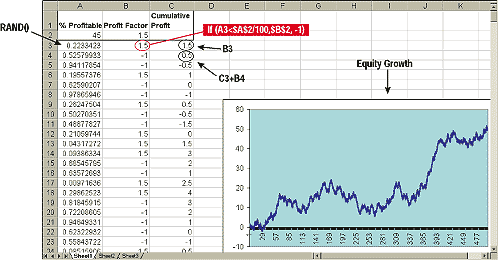QUANTITATIVE ANALYSIS
What Can You Realistically Expect From Your Trading System?
Determining Equity Growth Performance
by John F. Ehlers and Mike Barna
What are the merits of using technical analysis trading systems? Evaluate them here.
Technical analysts have the option of trading with either discretionary or systematic techniques. Discretionary traders tend to integrate life experience, knowledge, and technical indicators to make trading decisions. In this way they can, and have, made spectacular amounts of money. System traders, on the other hand, rely on trading signals automatically generated by computer programs. They don't really need to know much about the market, or have much experience. Their confidence lies in the ability of their computerized systems. In this article we will show you how to determine what you can realistically expect from your trading system, rather than how to manipulate the statistics.
SYSTEM STATISTICS
If you are going to risk your hard-earned money there are a number of statistics that are important, such as maximum drawdown. That, plus the required margin, is the absolute minimum amount of money you should have in your account to avoid a margin call with reasonable probability. Another important statistic is the average profit per trade, because you have to cover your transaction costs, commission, and slippage before you can start making a profit. You have to pay attention to the number of consecutive losers, because that's really the test of how strong your stomach must be to trade the system.
Essentially, there are two statistics that enable you to assess the performance you can expect: percentage of profitable trades and the profit factor. As a trader, you want to have winners with as high a percentage as possible. However, if you make more on winning trades than you lose on losing ones, it's not necessary for the percentage of profitable trades to be greater than 50%. Your profit factor is the ratio of gross winnings to gross losses (in terms of gaming, this is referred to as the payout probability). But determining whether a particular trade is a winner or loser will not help you establish your system's performance. For that, you need to introduce randomization.

FIGURE 1: Spreadsheet setup. The equity growth generator is relatively simple to set up. The equity curve visually displays the results.
...Continued in the March 2002 issue of Technical Analysis of STOCKS
& COMMODITIES
John Ehlers is an electrical engineer working in electronic research and development, and has been a private trader since 1978. He is a pioneer in introducing maximum entropy spectrum analysis to technical trading through his MESA computer program. He may be reached at john@mesasoftware.com. Mike Barna is a former astronautical engineer and is currently a trading systems designer and custom programmer. He has written many commercial trading systems at his company, Trading Systems Design and Analysis. Over the last six years he has collaborated with John Ehlers in the design of profitable and popular trading systems. He may be reached at tsda@attglobal.net.
Excerpted from an article originally published in the March 2002 issue of Technical Analysis of STOCKS & COMMODITIES magazine. All rights reserved. © Copyright 2002, Technical Analysis, Inc.